[English] 日本語
 Yorodumi
Yorodumi- PDB-1kkq: Crystal structure of the human PPAR-alpha ligand-binding domain i... -
+ Open data
Open data
- Basic information
Basic information
| Entry | Database: PDB / ID: 1kkq | ||||||
|---|---|---|---|---|---|---|---|
| Title | Crystal structure of the human PPAR-alpha ligand-binding domain in complex with an antagonist GW6471 and a SMRT corepressor motif | ||||||
 Components Components |
| ||||||
 Keywords Keywords |  TRANSCRIPTION / nuclear corepressor nuclear hormone receptors antagonist TRANSCRIPTION / nuclear corepressor nuclear hormone receptors antagonist | ||||||
| Function / homology |  Function and homology information Function and homology informationpositive regulation of transformation of host cell by virus / regulation of fatty acid transport / Loss of MECP2 binding ability to the NCoR/SMRT complex / regulation of fatty acid metabolic process / enamel mineralization / negative regulation of cell growth involved in cardiac muscle cell development / positive regulation of fatty acid oxidation / negative regulation of androgen receptor signaling pathway / regulation of cellular ketone metabolic process / cellular response to fructose stimulus ...positive regulation of transformation of host cell by virus / regulation of fatty acid transport / Loss of MECP2 binding ability to the NCoR/SMRT complex / regulation of fatty acid metabolic process / enamel mineralization / negative regulation of cell growth involved in cardiac muscle cell development / positive regulation of fatty acid oxidation / negative regulation of androgen receptor signaling pathway / regulation of cellular ketone metabolic process / cellular response to fructose stimulus / behavioral response to nicotine / nuclear glucocorticoid receptor binding / negative regulation of appetite / positive regulation of fatty acid beta-oxidation / lipoprotein metabolic process / negative regulation of hepatocyte apoptotic process / mitogen-activated protein kinase kinase kinase binding / negative regulation of leukocyte cell-cell adhesion / ubiquitin conjugating enzyme binding / Notch binding / negative regulation of glycolytic process / negative regulation of sequestering of triglyceride / nuclear steroid receptor activity / DNA-binding transcription activator activity / positive regulation of fatty acid metabolic process / nitric oxide metabolic process / NR1H2 & NR1H3 regulate gene expression to control bile acid homeostasis / positive regulation of ATP biosynthetic process /  NFAT protein binding / Notch-HLH transcription pathway / negative regulation of cholesterol storage / NFAT protein binding / Notch-HLH transcription pathway / negative regulation of cholesterol storage /  estrous cycle / negative regulation of macrophage derived foam cell differentiation / Regulation of MECP2 expression and activity / negative regulation of phosphatidylinositol 3-kinase/protein kinase B signal transduction / negative regulation of cytokine production involved in inflammatory response / epidermis development / estrous cycle / negative regulation of macrophage derived foam cell differentiation / Regulation of MECP2 expression and activity / negative regulation of phosphatidylinositol 3-kinase/protein kinase B signal transduction / negative regulation of cytokine production involved in inflammatory response / epidermis development /  phosphatase binding / MDM2/MDM4 family protein binding / positive regulation of lipid biosynthetic process / nuclear retinoid X receptor binding / NR1H3 & NR1H2 regulate gene expression linked to cholesterol transport and efflux / negative regulation of signaling receptor activity / negative regulation of reactive oxygen species biosynthetic process / positive regulation of gluconeogenesis / response to organonitrogen compound / RORA activates gene expression / transcription repressor complex / cellular response to starvation / negative regulation of blood pressure / phosphatase binding / MDM2/MDM4 family protein binding / positive regulation of lipid biosynthetic process / nuclear retinoid X receptor binding / NR1H3 & NR1H2 regulate gene expression linked to cholesterol transport and efflux / negative regulation of signaling receptor activity / negative regulation of reactive oxygen species biosynthetic process / positive regulation of gluconeogenesis / response to organonitrogen compound / RORA activates gene expression / transcription repressor complex / cellular response to starvation / negative regulation of blood pressure /  lactation / Regulation of lipid metabolism by PPARalpha / hormone-mediated signaling pathway / cerebellum development / response to nutrient / BMAL1:CLOCK,NPAS2 activates circadian gene expression / SUMOylation of transcription cofactors / fatty acid metabolic process / Activation of gene expression by SREBF (SREBP) / negative regulation of miRNA transcription / lactation / Regulation of lipid metabolism by PPARalpha / hormone-mediated signaling pathway / cerebellum development / response to nutrient / BMAL1:CLOCK,NPAS2 activates circadian gene expression / SUMOylation of transcription cofactors / fatty acid metabolic process / Activation of gene expression by SREBF (SREBP) / negative regulation of miRNA transcription /  gluconeogenesis / HDACs deacetylate histones / Downregulation of SMAD2/3:SMAD4 transcriptional activity / negative regulation of transforming growth factor beta receptor signaling pathway / circadian regulation of gene expression / response to insulin / SUMOylation of intracellular receptors / Heme signaling / gluconeogenesis / HDACs deacetylate histones / Downregulation of SMAD2/3:SMAD4 transcriptional activity / negative regulation of transforming growth factor beta receptor signaling pathway / circadian regulation of gene expression / response to insulin / SUMOylation of intracellular receptors / Heme signaling /  wound healing / Transcriptional activation of mitochondrial biogenesis / wound healing / Transcriptional activation of mitochondrial biogenesis /  regulation of circadian rhythm / regulation of circadian rhythm /  transcription coactivator binding / PPARA activates gene expression / Cytoprotection by HMOX1 / NOTCH1 Intracellular Domain Regulates Transcription / negative regulation of inflammatory response / Constitutive Signaling by NOTCH1 PEST Domain Mutants / Constitutive Signaling by NOTCH1 HD+PEST Domain Mutants / transcription coactivator binding / PPARA activates gene expression / Cytoprotection by HMOX1 / NOTCH1 Intracellular Domain Regulates Transcription / negative regulation of inflammatory response / Constitutive Signaling by NOTCH1 PEST Domain Mutants / Constitutive Signaling by NOTCH1 HD+PEST Domain Mutants /  nuclear matrix / DNA-binding transcription repressor activity, RNA polymerase II-specific / Transcriptional regulation of white adipocyte differentiation / HCMV Early Events / Nuclear Receptor transcription pathway / nuclear matrix / DNA-binding transcription repressor activity, RNA polymerase II-specific / Transcriptional regulation of white adipocyte differentiation / HCMV Early Events / Nuclear Receptor transcription pathway /  histone deacetylase binding / transcription corepressor activity / histone deacetylase binding / transcription corepressor activity /  nuclear receptor activity / nuclear receptor activity /  Circadian Clock / response to estradiol / Circadian Clock / response to estradiol /  heart development / DNA-binding transcription activator activity, RNA polymerase II-specific / response to ethanol / DNA-binding transcription factor binding / RNA polymerase II-specific DNA-binding transcription factor binding / sequence-specific DNA binding / heart development / DNA-binding transcription activator activity, RNA polymerase II-specific / response to ethanol / DNA-binding transcription factor binding / RNA polymerase II-specific DNA-binding transcription factor binding / sequence-specific DNA binding /  cell differentiation / response to hypoxia / cell differentiation / response to hypoxia /  nuclear body / DNA-binding transcription factor activity, RNA polymerase II-specific / RNA polymerase II cis-regulatory region sequence-specific DNA binding / DNA-binding transcription factor activity nuclear body / DNA-binding transcription factor activity, RNA polymerase II-specific / RNA polymerase II cis-regulatory region sequence-specific DNA binding / DNA-binding transcription factor activitySimilarity search - Function | ||||||
| Biological species |   Homo sapiens (human) Homo sapiens (human) | ||||||
| Method |  X-RAY DIFFRACTION / X-RAY DIFFRACTION /  SYNCHROTRON / SYNCHROTRON /  MOLECULAR REPLACEMENT / Resolution: 3 Å MOLECULAR REPLACEMENT / Resolution: 3 Å | ||||||
 Authors Authors | Xu, H.E. / Stanley, T.B. / Montana, V.G. / Lambert, M.H. / Shearer, B.G. / Cobb, J.E. / McKee, D.D. / Galardi, C.M. / Nolte, R.T. / Parks, D.J. | ||||||
 Citation Citation |  Journal: Nature / Year: 2002 Journal: Nature / Year: 2002Title: Structural basis for antagonist-mediated recruitment of nuclear co-repressors by PPARalpha. Authors: Xu, H.E. / Stanley, T.B. / Montana, V.G. / Lambert, M.H. / Shearer, B.G. / Cobb, J.E. / McKee, D.D. / Galardi, C.M. / Plunket, K.D. / Nolte, R.T. / Parks, D.J. / Moore, J.T. / Kliewer, S.A. ...Authors: Xu, H.E. / Stanley, T.B. / Montana, V.G. / Lambert, M.H. / Shearer, B.G. / Cobb, J.E. / McKee, D.D. / Galardi, C.M. / Plunket, K.D. / Nolte, R.T. / Parks, D.J. / Moore, J.T. / Kliewer, S.A. / Willson, T.M. / Stimmel, J.B. #1:  Journal: Proc.Natl.Acad.Sci.USA / Year: 2001 Journal: Proc.Natl.Acad.Sci.USA / Year: 2001Title: Structural determinants of ligand binding selectivity between the peroxisome proliferator-activated receptors Authors: Xu, H.E. / Lambert, M.H. / Montana, V.G. / Willson, T.M. | ||||||
| History |
|
- Structure visualization
Structure visualization
| Structure viewer | Molecule:  Molmil Molmil Jmol/JSmol Jmol/JSmol |
|---|
- Downloads & links
Downloads & links
- Download
Download
| PDBx/mmCIF format |  1kkq.cif.gz 1kkq.cif.gz | 243.2 KB | Display |  PDBx/mmCIF format PDBx/mmCIF format |
|---|---|---|---|---|
| PDB format |  pdb1kkq.ent.gz pdb1kkq.ent.gz | 196.8 KB | Display |  PDB format PDB format |
| PDBx/mmJSON format |  1kkq.json.gz 1kkq.json.gz | Tree view |  PDBx/mmJSON format PDBx/mmJSON format | |
| Others |  Other downloads Other downloads |
-Validation report
| Arichive directory |  https://data.pdbj.org/pub/pdb/validation_reports/kk/1kkq https://data.pdbj.org/pub/pdb/validation_reports/kk/1kkq ftp://data.pdbj.org/pub/pdb/validation_reports/kk/1kkq ftp://data.pdbj.org/pub/pdb/validation_reports/kk/1kkq | HTTPS FTP |
|---|
-Related structure data
| Related structure data |  1k7lS S: Starting model for refinement |
|---|---|
| Similar structure data |
- Links
Links
- Assembly
Assembly
| Deposited unit | 
| ||||||||
|---|---|---|---|---|---|---|---|---|---|
| 1 | 
| ||||||||
| 2 | 
| ||||||||
| 3 | 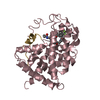
| ||||||||
| 4 | 
| ||||||||
| Unit cell |
|
- Components
Components
| #1: Protein | Mass: 30442.582 Da / Num. of mol.: 4 / Fragment: PPAR-alpha LBD Source method: isolated from a genetically manipulated source Source: (gene. exp.)   Homo sapiens (human) / Gene: human / Plasmid: PRSETA / Species (production host): Escherichia coli / Organ (production host): LIVER / Production host: Homo sapiens (human) / Gene: human / Plasmid: PRSETA / Species (production host): Escherichia coli / Organ (production host): LIVER / Production host:   Escherichia coli BL21(DE3) (bacteria) / Strain (production host): BL21 DE3 / References: UniProt: Q07869 Escherichia coli BL21(DE3) (bacteria) / Strain (production host): BL21 DE3 / References: UniProt: Q07869#2: Protein/peptide | Mass: 2240.667 Da / Num. of mol.: 4 / Fragment: SMRT receptor interacting motif / Source method: obtained synthetically Details: SMRT receptor interacting motif: This sequence occurs naturally in humans. References: UniProt: Q9Y618 #3: Chemical | ChemComp-471 / #4: Water | ChemComp-HOH / |  Water Water |
|---|
-Experimental details
-Experiment
| Experiment | Method:  X-RAY DIFFRACTION / Number of used crystals: 1 X-RAY DIFFRACTION / Number of used crystals: 1 |
|---|
- Sample preparation
Sample preparation
| Crystal | Density Matthews: 2.76 Å3/Da / Density % sol: 55.49 % | ||||||||||||||||||||||||||||||||||||
|---|---|---|---|---|---|---|---|---|---|---|---|---|---|---|---|---|---|---|---|---|---|---|---|---|---|---|---|---|---|---|---|---|---|---|---|---|---|
Crystal grow | Temperature: 293 K / Method: vapor diffusion, hanging drop / pH: 7 Details: PEG35K, pH 7.0, VAPOR DIFFUSION, HANGING DROP, temperature 293K | ||||||||||||||||||||||||||||||||||||
| Crystal grow | *PLUS | ||||||||||||||||||||||||||||||||||||
| Components of the solutions | *PLUS
|
-Data collection
| Diffraction | Mean temperature: 100 K |
|---|---|
| Diffraction source | Source:  SYNCHROTRON / Site: SYNCHROTRON / Site:  APS APS  / Beamline: 17-ID / Wavelength: 1 Å / Beamline: 17-ID / Wavelength: 1 Å |
| Detector | Type: MARRESEARCH / Detector: CCD / Date: Mar 24, 2001 |
| Radiation | Monochromator: Monochromator crystal / Protocol: SINGLE WAVELENGTH / Monochromatic (M) / Laue (L): M / Scattering type: x-ray |
| Radiation wavelength | Wavelength : 1 Å / Relative weight: 1 : 1 Å / Relative weight: 1 |
| Reflection | Resolution: 3→20.99 Å / Num. all: 29727 / Num. obs: 29380 / % possible obs: 99 % / Observed criterion σ(F): 0 / Observed criterion σ(I): 0 / Redundancy: 4 % / Biso Wilson estimate: 50 Å2 / Rmerge(I) obs: 0.023004 / Rsym value: 0.066 / Net I/σ(I): 23.3 |
| Reflection shell | Resolution: 3→3.11 Å / Redundancy: 4 % / Rmerge(I) obs: 0.158 / Mean I/σ(I) obs: 2 / Num. unique all: 2810 / Rsym value: 0.062 / % possible all: 96.1 |
| Reflection | *PLUS Lowest resolution: 30 Å / % possible obs: 99 % / Rmerge(I) obs: 0.068 |
- Processing
Processing
| Software |
| ||||||||||||||||||||||||||||||||||||||||
|---|---|---|---|---|---|---|---|---|---|---|---|---|---|---|---|---|---|---|---|---|---|---|---|---|---|---|---|---|---|---|---|---|---|---|---|---|---|---|---|---|---|
| Refinement | Method to determine structure : :  MOLECULAR REPLACEMENT MOLECULAR REPLACEMENTStarting model: 1k7L Resolution: 3→20.99 Å / Rfactor Rfree error: 0.006 / Data cutoff high absF: 4983740.5 / Data cutoff high rms absF: 4983740.5 / Data cutoff low absF: 0 / Isotropic thermal model: RESTRAINED / Cross valid method: THROUGHOUT / σ(F): 0 / σ(I): 0 / Stereochemistry target values: Engh & Huber
| ||||||||||||||||||||||||||||||||||||||||
| Displacement parameters | Biso mean: 50.1 Å2
| ||||||||||||||||||||||||||||||||||||||||
| Refine analyze |
| ||||||||||||||||||||||||||||||||||||||||
| Refinement step | Cycle: LAST / Resolution: 3→20.99 Å
| ||||||||||||||||||||||||||||||||||||||||
| Refine LS restraints |
| ||||||||||||||||||||||||||||||||||||||||
| LS refinement shell | Resolution: 3→3.19 Å / Rfactor Rfree error: 0.022 / Total num. of bins used: 6
| ||||||||||||||||||||||||||||||||||||||||
| Xplor file |
| ||||||||||||||||||||||||||||||||||||||||
| Software | *PLUS Name: CNX2000 / Classification: refinement | ||||||||||||||||||||||||||||||||||||||||
| Refinement | *PLUS Lowest resolution: 30 Å / σ(F): 0 / % reflection Rfree: 10 % / Rfactor obs: 0.257 / Rfactor Rfree : 0.29 : 0.29 | ||||||||||||||||||||||||||||||||||||||||
| Solvent computation | *PLUS | ||||||||||||||||||||||||||||||||||||||||
| Displacement parameters | *PLUS Biso mean: 50.1 Å2 | ||||||||||||||||||||||||||||||||||||||||
| Refine LS restraints | *PLUS
| ||||||||||||||||||||||||||||||||||||||||
| LS refinement shell | *PLUS Rfactor Rfree: 0.421 / % reflection Rfree: 7.9 % / Rfactor Rwork: 0.386 |
 Movie
Movie Controller
Controller





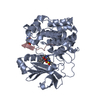
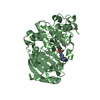
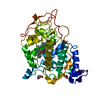
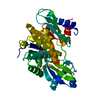

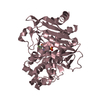
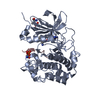
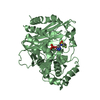
 PDBj
PDBj













